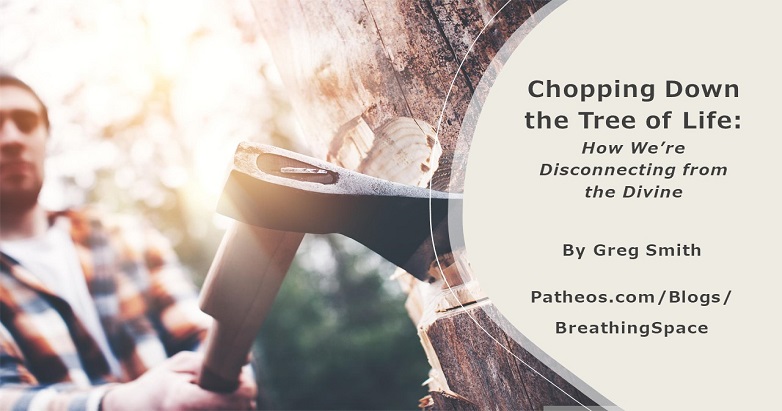When my family left the intrusion of the city and the noise of neighbors, I traded my boyhood playground for Christopher Robin’s hundred-acre wood. My brother and I spent our magical childhood playing among the trees. We climbed in their mighty arms and built forts in their branches. We chased each other around the spreading roots of our great oak guardians. Our young friends the saplings swayed as we swung on their pliant trunks. Since that time, sacred trees continue to call me, reawakening the boy in my heart.

I did not know at the time that trees are holy to almost every world religion. To people on every continent, trees symbolize divine communication. With their roots in the earth and their branches reaching the sky, they offer a link between earthbound humanity and celestial wisdom. As the open leaves absorb energy from the sun, so we stretch our arms heavenward in our desire to know the Creator. As a tree’s roots penetrate the earth to soak up its water, so humanity reaches back to its roots in our thirst for sacred truth.
Despite humanity’s reverence for trees, rainforests disappear from our tropical sanctuaries at an alarming rate. Not only do we risk the loss of a natural resource, but we are also perilously close to destroying an important connection with the Divine. A look at comparative mythologies provides insight into what the tree means in the human relationship with Spirit.
The Bodhi Tree
Long ago in India there lived a young prince named Siddhartha Gautama. To keep his son from all suffering, his father secluded him in three magnificent palaces, far from the sorrows of life. So far as the boy knew, things like old age, disease, and death did not exist. All of life was bliss.
Then one day as he wandered from the palace, a god appeared to him as a weakened old man. The next day the divine apparition came to him as a wretchedly diseased man. On the third day, the prince beheld a procession bearing a dead man to his funeral pyre. These three sights caused Siddhartha to question everything he had ever known.
On the fourth day, as he sat under a tree by the wayside, he met a serene monk in a yellow robe walking toward him. Determined to seek a spiritual answer to life’s troubles, young Gautama followed the ascetic path. Depriving himself of all worldly pleasures, he pressed on in his self-abasement. After abusing his body and starving himself nearly to death, finally he came to realize that he could gain nothing from this kind of life. He decided that there must be another way to enlightenment.
Siddhartha determined not to go further until he found illumination. Though he might waste away in his search, he decided to sit under the Bodhi tree to meditate. For forty days and nights, he sat unmoved by the temptations and attacks that came against him. But every demonic arrow fired at the young man became a flower that fell at his feet. At the end of his ordeal, Siddhartha attained enlightenment and became the Buddha.
A Universal Symbol
As a universal symbol, the meditation spot under the tree becomes a sacred place where enlightenment takes place. Without having ever achieved the enlightenment that the young prince gained, I know that when things get confusing in my life, a walk through the forest or meditating beneath a tree can bring clarity. The tree that grows toward the sun becomes a symbol of the human journey toward God. The roots that reach deep into the earth represent exploration of the subconscious mind. The Bodhi tree became, as it were, a conductor of divine energy, sheltering Siddhartha from the storms that raged against Gautama. But Buddhism is not alone among the ancient relations in its veneration of the tree.
Yggdrasil
The Norse tradition tells of Yggdrasil, the great tree whose branches support the nine worlds. According to Nordic cosmology, nine worlds, or planes of existence, comprise the universe. These include the realms of humans, giants, elves, dwarves, and the like. With each world suspended on the Yggdrasil, this tree became a connecting point from one dominion to another.
Odin sought to gain wisdom from the well of Mimir, that fountain of the collective unconscious that reveals hidden secrets. This well lay beneath the branches of Yggdrasil. To gain Mimir’s permission to look into the well, Odin had to make a sacrifice. Gouging out one of his own eyes, he threw it into the well. Drinking deeply from the pool, he gained the esoteric knowledge he desired, then broke off a branch of Yggdrasil to fashion his mighty spear Gungnir.
Wisdom unshared is a horrible thing, so he decided to find a way to bestow this blessing on the world. Wounding himself with his spear, he hung himself on the tree. Nine days the god remained wounded on the tree until he received mystical sight and beheld the runes of wisdom. Transformed by this secret knowledge, he descended from the tree and brought wisdom to the middle world of humankind.
The Tree of Wisdom
If Yggdrasil is analogous to wisdom, this myth tells us that wisdom’s gifts come only at a price. The tree is no longer a just place of enlightenment, but a place where wisdom is bought with personal suffering. Often life teaches valuable lessons that cannot be learned without being in a place of need and pain. Vulnerability on the suffering tree makes the human heart ready to receive the gift of wisdom. So, we know that in mythology, the tree is both a place of quiet enlightenment, as well as a shamanic revelation that comes through pain.
Yggdrasil also teaches that wisdom is where all worlds come together. As the nine worlds hang on its branches, so the world of each individual is dependent on communal truth and understanding. None of us is separate from those around us. We may hang on separate branches, but we belong to the same tree.
Trees of Life
According to the Hebrew Scriptures, God placed Adam and Eve in Eden and permitted them to eat from any tree except the Tree of the Knowledge of Good and Evil. Tempted by the serpent who told them their eyes would be opened, they disobeyed and partook of its fruit. As punishment for their sin, God cast them out of Eden and placed an angel with a flaming sword at the garden gate to keep them from gaining access to the Tree of Eternal Life. Later, Ezekiel would prophesy about a coming day when a fountain will flow from the throne of “God, beside which will grow trees which give life to the nations.
The Tree of Crucifixion
In the New Testament, the cross of Jesus marks humanity’s attainment of that forbidden Tree of Life. Just as Odin for wisdom suffered on the Yggdrasil from a self-inflicted wound, so Jesus gave himself up to the pain of the cross. The mystery of the cross is that eternal or ultimate life comes only through self-annihilation. “I am crucified with Christ,” the apostle Paul writes, meaning that to gain wisdom and perfection there must be a death of the old self. Only by giving up the old life and being resurrected into a new mode of existence can a person eat from the Tree that was once forbidden. Only then can humanity attain the promise of Eden, that our eyes shall be opened. “To him who overcomes until the end,” the book of Revelation says, “I will give to eat from the Tree of Life.”
Modern Myth
In mythology around the world, the tree is symbolic of wisdom attained at a great price. From India to Sweden, from Eden to the cross, the tree represents arcane knowledge and communication with the divine. But what of contemporary humanity? Do we lose ourselves in a mythless world? No—instead, we recognize the emerging myths around us. Let us examine one more myth, an American folktale that not accidentally leaves out the mention of God.
Paul Bunyan—Feller of Trees
Paul Bunyan appeared on a Massachusetts beach in a giant cradle, his cry as loud as the windstorm that howled the night he came. The town cared for him as he grew, until one Christmas they decided his enormity was useful and presented him with a gigantic axe. This started Paul in his career as a lumberjack.
Chopping his way from one coast to another, he cleared precious farmland and provided timber for building. Among other accomplishments, the giant is said to have built Pike’s Peak, straightened out the Missouri River, and released the waters of Niagara Falls. It seemed there was nothing Paul couldn’t do. The myth of Paul Bunyan never once mentions God—because it’s all about rugged individualism and human achievement, and not divine experience.
Then a challenger entered the scene. A steam saw salesperson named Joe Muffaw claimed to be able to fell more trees than Paul could and challenged him to a competition. All day they dueled, Paul’s axe swinging nonstop, and Joe’s steam saw noisily buzzing. When the contest ended, the steam beat Paul by a hair. Machine overcame the might of man, and modern technology forced Paul into an early Alaskan retirement.
Lessons from a Logger
Paul Bunyan tells us two things:
- The myth contrasts Americans with the many peoples who have always venerated the tree as a channel of wisdom. At the dawn of the nation’s history, this country boasted thousands of miles of virgin forest. But as Americans made “progress” across the country, they decided that the trees were better used for fuel and furniture than for quiet contemplation. Johnny Appleseed just couldn’t keep up with the swinging axe of human achievement. Paul Bunyan represented not the power of one individual, but the ability of a nation to bend nature to the human will. This manipulation of the environment comes at a great price: the sacrifice of the Wisdom Tree itself. Paul’s seeming accomplishments mark the United States’ loss of spirituality and wisdom, embodied in the tree.
- As the Age of Enlightenment gave way to the Industrial Revolution, even the accomplishments of human spirit were overcome by the efficiency of the machine. How many have been technologized out of a job when computers and manufacturing robots could work tirelessly and for free. In the United States, using axes to destroy sacred trees isn’t enough. It must be done with machines, so our hands won’t be bloodied with the sap of their death. Our innovation has outpaced our spirituality and left behind a wasteland. Across the country, loggers do their violent job with the deafening roar of a machine that fells mighty trees in seconds, then moves to its next victim. Around the world, rainforests that turn carbon dioxide into oxygen disappear at a staggering rate, contributing to climate change.
Returning to Nature
Watching this, I am struck by the desert of the modern spirit, and our need to return to the tree. It is under the tree where we gain enlightenment, and it’s in hanging upon the tree that we learn the sacrifice necessary for wisdom. Climbing in its branches we regain that childlike spirit that Christ said was needed for eternal life. When the tree reminds us of the loftiness of God, we cut it down because we don’t like to see how small we are. Yet only with the Tree of Life as a ladder to the skies can we ever ascend to the heavens.
Paul Bunyan is a symbol of the vast achievements of human striving. People left to their own devices will cut down the tree of life. Bunyan represents the devastation of spirit that happens when we cut the tree of the spirit out of our own lives. Yet in his recklessness, Paul does show one bit of wisdom from which we can learn. When he is bested by technology, he retires to Alaska—that place of unlimited nature where trees abound.
Like Paul, many of us find ourselves so inundated by technological “advances” that we long for something simpler and more meaningful. We yearn to retreat, to retire to that place where Trees of Life thrive, and God speaks daily in a land of midnight sun and northern lights. The good news is that we don’t have to move to Alaska to find God in the wild. Wisdom is just a stone’s throw away at the closest oak or the nearest elm. When we find ourselves guilty of being Paul Bunyan’s disciples rather than students of the Spirit, it is then that we need to put our axes down and sit beneath the tree. Only in a return to nature can we gain what we need the most: enlightenment, wisdom, and the self-sacrifice that leads to ultimate life. And only then will we see the need to restore the trees that give our planet eternal life.












